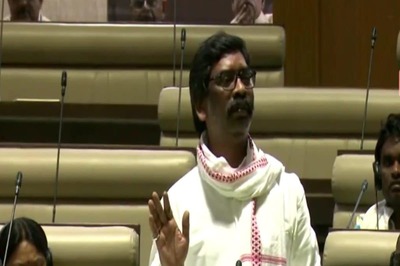
views
Watching Sunita painting swirls of white acrylic paint is calming, almost. Her husband Prabhat sits a few feet away waiting for the questions to begin. He is a children’s writer in Hindi and she, like her mother and grandmother, is an artist from the Meena tribe of Rajasthan. For a while, there is no talking as the language barrier stands between us.
A jackal is starting to take shape on the brown sheet of canvas Sunita is working on, at the Book Building in Thiruvamiyur. This will be one of the many pages of a book that she and her husband are working on together with Tara Books, which is to be released in December this year. Finally, our photographer, also playing translator at this point, is ready to go. “We were trying to think of a good story,” Prabhat starts off. “And that is when I remembered the story that Sunita told me about the jackal and the crane.”
Titled the same, this book to be is based on an old Rajasthani folk tale. The jackal eats up all the animals and one day, after a long drink of water, his belly bursts. Then he calls upon the tailor bird to sew him back together.
Meena laughs at this point. She is now a little more at ease. “My grandfather told me this story when I was eight,” she recalls. This was also roughly around the same time that she started painting. “All the women do it (Meena work) back home,” she explains. “But not with this paint,” she points at the bottle. “We use harmich (mud colouring) in our village.” The painting, as one would expect, is not done on paper canvases, but on the mud floors and walls of each house. “Especially during Diwali,” Sunita’s face lights up.
This is a tribal art form that has not systematically evolved on to paper. So there have been fears that the art will die out as lifestyles of people in this community have begun to change. Attempts such as these will go a long way in popularising it commercially.
As is traditional of this style of painting, the only colours used are white, with sparse touches of red to contrast the brown mud colour. “I draw whatever comes to my mind,” says Sunita.
However as she instinctively weaves patterns with her paint-soaked cotton cloth, it is evident that the signature feature of the art are the animal motifs.
Here, often one finds one animal inside another, perhaps why the story of the hungry jackal makes for a good choice of title for the book.
















Comments
0 comment